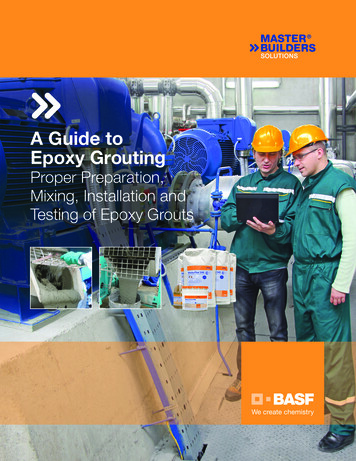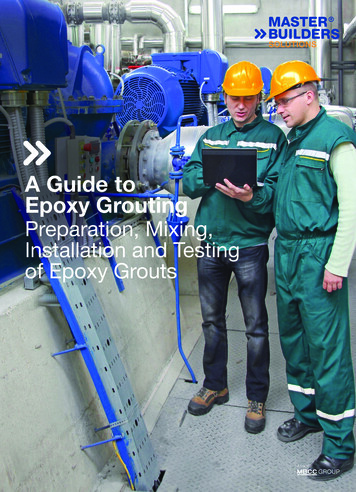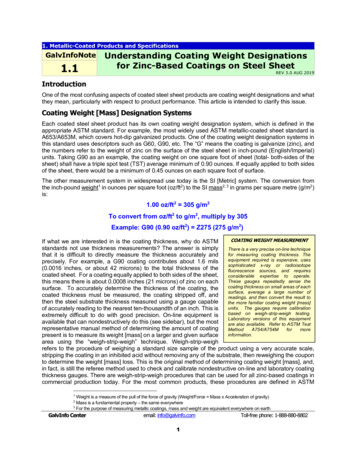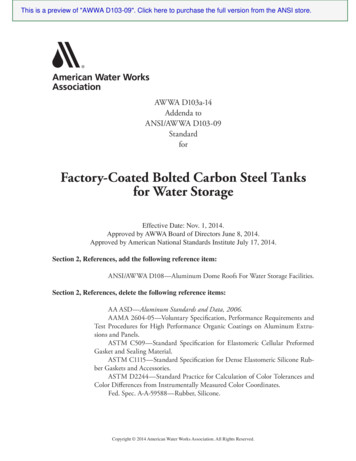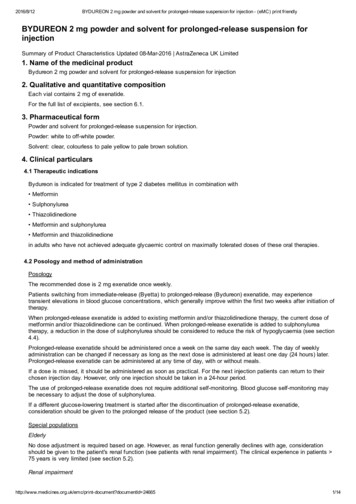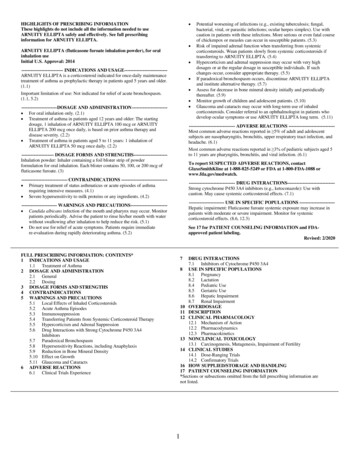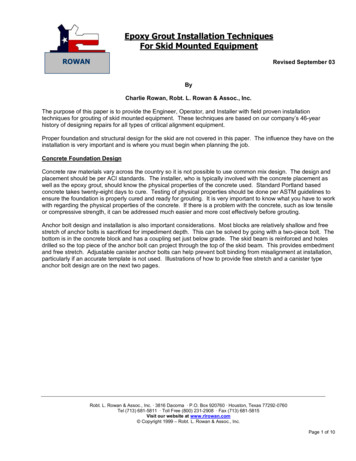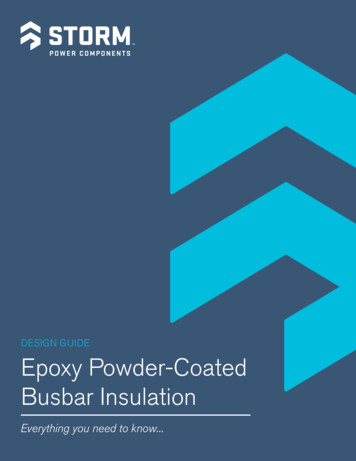
Transcription
Epoxy Powder-Coated Busbar Insulation Product GuideDESIGN GUIDEEpoxy Powder-CoatedBusbar InsulationEverything you need to know.Responsive Manufacturing T M1
Epoxy Powder-Coated Busbar Insulation Product GuideStorm – The PremiereDielectric Finishing ServiceImprove Product Footprint with Epoxy Powder Coating Insulation.In today’s power-hungry and ever-shrinking environment, equipment footprint has become more critical than ever. As well, the complexityand volume of other mechanical and electrical components within the overall cabinet structure demand maximum flexibility in partplacement. Applying epoxy powder-coated insulation can substantially reduce overall design constraints, potentially leading to more costeffective designs with improved assembly protocols.Consider the Benefits ofEpoxy Powder CoatingReady, Right, Sure.Storm Power Components has the experience, capabilities,and equipment to manufacture high dielectric epoxy powdercoated insulation for busbars. The free-flowing powder cancoat any size, shape, and type of busbar needed, which isperfect for OEMs needing durable and tight-fitting insulation.Reduced Flash-OverReduced Operating TemperatureEpoxy powder-coated insulation decreases the risk of flash-overs.Although this has not been independently verified, someThe insulation is essentially directly bonded to the conductorcustomers have found that epoxy powder-coated busbars haveleaving no air gap. As a result, the likelihood of partial dischargesreduced operating temperatures. Because there is no air gapbetween the conductor surface and the insulation barrier isbetween the conductor and the insulation, heat transfers smoothlydecreased.through the epoxy powder insulation, and the increased surfaceReduced Insulation FailureWhen cables or pre-insulated busbar are bent to conform to thearea versus a bare conductor provides efficient heat dissipation.Increased Versatilityrequired routing path, the insulation undergoes compression andEpoxy powder coating is the perfect insulation for conductors thattension at all locations where the conductor was changed. Theseare oddly shaped, have unique sizes, or those which may be knownforces manipulate the insulation, which can lead to prematureto undergo stress during installation. Unlike most other types ofinsulation failure. The smooth coverage epoxy powder coatinginsulation, the epoxy powder is applied after all required bending,provides, eliminates these stresses, thereby reducing the chancescontouring, punching and milling is complete. In doing so, theof insulation failure.insulation will be consistent throughout the entire conductor run.Responsive Manufacturing T M3
Epoxy Powder-Coated Busbar Insulation Product GuideEpoxy Powder-Coated Busbar Insulation Product GuideMaterial CharacteristicsTwo Methods in CoatingElectrostatic Spray or Fluidized Bed?How It WorksThe choice between electrostatic spray or fluidized bed powder coating is determined by the dielectric strength requirement of insulationapplication. The general rule of thumb is that a high-voltage busbar should be fluid dipped to achieve a thickness greater than 0.12inches. Complicated shapes should also be fluid dipped for even, thick coating on bends and turns. Copper busbars or other componentsEpoxy is a dielectric insulation material with a manufacturer’s insulation rating of 800 volts/mil (.001”), at a minimum of 10 mils (.010”).with flat, open geometry are more suitable for spraying.The powder used in this process is a thermosetting dry powder that, once heated, flows uniformly over the copper substrate (plated orun-plated). This coating can be applied in thicknesses ranging from 6 mil (.006”) to 120 mil (.120”). When the epoxy powder cures, across-link occurs increasing the molecular weight and insulation capability. Reference the graph below to compare Epoxy powder to otherpolymers.Standard Variety EPOXYMYLARTIME IN HOURS10,000PVCTEST1200HRS1,000100Figure 4. Insulation life curvesplotted according to the Arrheniusreaction theory162040100120140160180TEMPERATURE C (1/K)Epoxy powder not only protects against corrosion, but also carries a high manufacturer’s insulation rating of 800 volts/mil (0.001”) atElectrostatic SprayFluidized BedBefore the epoxy powder is applied to the substrate, applicationParts are “dipped” into epoxy powder that is suspended in an airtechnicians should determine how much powder is to be appliedcontained, aerated hopper. This is accomplished by releasingto meet the desired dielectric characteristics of each part. This iscompressed air through a porous plate located in the bottom oftypically accomplished by varying the ratio of voltage, airflow, andthe hopper. As result, the epoxy powder “floats” in the hopper in apowder. Components should be treated to an optimumfluidized state. This creates a smooth, continuous epoxy powdertemperature prior to applying the powder, then placed in a curingcoating over the substrate as it is “dipped.” Greater thicknesses ofoven. As the thermo-set powder is heated, it will begin to melt andepoxy powder can be achieved with this method of application thanflow out, enabling it to form a higher molecular weight polymer,with electrostatic spray. As with sprayed components, the coatedfusing both to itself and the substrate.parts are then sent to a curing oven.a minimum of 10 mils (0.01 inches). Due to safety consideration, it is recommended that a High-Pot (High Potential) test is performed,rather than rely on film thickness.Tensile strength of the coating applied on raw and plated copper bar is in the range of 7500 PSI, and has a thermal UL rating of 130degrees C. Epoxy powder coating’s high dielectric strength can be varied based on the application process and component preparation.Responsive Manufacturing T M4Responsive Manufacturing T M5
Epoxy Powder-Coated Busbar Insulation Product GuideEpoxy Powder-Coated Busbar Insulation Product GuideDesign Considerations5. Multi-process capability:Can the manufacturer execute both fluidized bed and electrostatic sprayStorm Power Components specializes in applying insulation at extreme thicknesses, up to 100mil or more.methods? Does the manufacturer control the full process, from cutting,bending, and punching, to electroplating, and finally, insulating? Thishelps ensure clean execution of all steps in the process and a betterEpoxy powder insulation is significantly denser than other spray-on applications, and unlike the powder coating often used for aestheticfinished product with the shortest possible lead times.purposes, the total application thickness is typically greater than 10 mils. This capability allows for medium and high voltage applications6. Avoid contact between thesurrounding environment and yourbusbar.up to 35,000 volts, allowing for drastic changes in the design of your medium and high voltage switchgear. Moreover, the versatility ofthe process and insulation allows it to be used in areas that are not normally considered. OEMs utilizing this insulation technology canproduce more competitive products - achieving a leg up on their competition.When designing a busbar to be epoxy powder-coated or evaluating a manufacturer, make sure to:Contact between the insulation and surrounding components couldcause wear in the epoxy powder due to vibration or thermal cycling of1. When possible utilize full round edge barprofiles:the components.7. Don’t be afraid to use two or moreinsulated busbar conductors toconnect one.The contoured edge of this profile allows for better adhesion of the epoxy powder as it“wraps” the edge of the busbar.2. Avoid small cut-outs or holes in theconductor:Does the manufacturer have the in-house engineering expertise toadvice you of the options possible to make these type of applicationssafe and reliable?Small profile cut-outs or holes are difficult to edge condition and could create weak areasprone to premature failure.3. Carefully consider design dimensions andlabels:Always dimension designs to the substrate, not the powder surface. Carefully considermasking location tolerances. Extremely tight tolerances on masking locations are difficultthat will be coated on the interior, be sure to allow increased tolerances for the thicknessof the powder to be applied. Allow for the largest reasonable bend radius. This will help thepowder flow more smoothly without build-up or thinning.OEMs using epoxy powder insulation can produce more competitiveproducts – achieving a leg up on their competition4. Expertise applying extraordinary thicknesses:the process, you may end up with non-conforming components, holes excessively filled, pooredge conditions, and premature failures.Responsive Manufacturing T MEpoxy powder coating’s high dielectricstrength can be varied based on theapplication process and componentpreparation. That’s just one reasonit’s recommended to perform at leasttwo types of testing procedures onfinished parts, Hi-Pot (High Potential)and Partial Discharge, to ensure thecomponent meets or exceeds theappropriate standards to ensure thatthe product will operate as designed.Moreover, rigorous testing will ensurethe epoxy powder has properlyadhered to the conductor surfaceitself.1. A Hi-Pot (High Potential) test shouldbe performed on all finished partsto ensure the finished product is acompletely homogenous insulationsurface, capable of maintaining itsintegrity throughout the productlife cycle. Hi-Pot testing at StormPower Components is carried out inaccordance with section §6.2.1 of theANSI/IEEE C37.20.2-1999 standard,which is the standard for bussing ofmetal-clad switchgear.2. Impact Testing – Sample parts areimpact tested utilizing a ball droptester to ensure the insulation meetsits specifications.and expensive to achieve. Consider allowing masking tolerances of /- .0625. For thru holesChoose a provider who can perform a variety of thicknesses. If the provider isn’t an expert inTesting CriteriaEpoxy powder insulation allowsfor drastic changes in the designof your medium- and highvoltage switchgear6Responsive Manufacturing T MIn addition to testing the finishedparts, you’ll also want to make surethe actual insulation products usedare certified through both ASTM andUnderwriters Laboratories (UL ).7
Epoxy Powder-Coated Busbar Insulation Product GuideEpoxy Powder-Coated Busbar Insulation Product GuideYour Application is likely an EpoxyPowder Insulation CandidateTrust the Experts forPremiere Dielectric FinishingEpoxy powder-coated busbar is readily used in almost all outdoor applications.For more than two decades, Storm Power Components hasprovided “Under One Roof” electrical component manufacturing.Higher Energy Densities for Energy StorageFor more than twenty-five years, Storm Power Components has been a responsive manufacturerSpace is a major issue when it comes to battery systems for hybrid commercial and industrial vehicles. By designing the battery layoutsof electrical conductors—bare, plated, insulated and laminated. Our power components areto accommodate closer packing the overall space can be reduced. Using thinner and more closely packed epoxy powder-coated copperprocessed through a number of finishes for a wide range of industries and applications. That’sbusbars, the conductors will contribute to the space savings design.just one of the many reasons OEMs around the world trust Team Storm to execute complexReduced Characteristic Impedance for IGBT Applicationsfinishing processes like epoxy powder coating.Variable frequency drives are used almost exclusively now as induction motor starter and drivers. With insulated gate bipolar transistor (IGBT)drives becoming larger and larger, the current carrying capacity of the DC link and inverter busbars are also increasing.Our engineering team provides invaluable insight and services throughout the design andmanufacturing process. From end-to-end product development to audits of existing copperbusbar designs, our expert insight can help you shorten lead times, lower costs, and improveUtilizing epoxy powder-coated copper busbars can provide increased ampacity per cross sectional area due to better thermal conductivity ofthe insulation. This translates into less required copper and more reliable inverter banks.product performance.Regardless of where you are in your design process, our engineers and designers can assistGate drive signal integrity is an absolute necessity for reducing harmonics and to keep the inverter stacks from failing. By reducing theyou. Whether you have a comprehensive written scope of work, a napkin sketch, a photo, or justcharacteristic impedance of the drive circuit by using epoxy powder-coated copper busbars, the gate current is less likely to be attenuated.idea, our knowledgeable and talented engineers and designers can develop a solution to helpThis ensures firing of the transistors when the microprocessor intends them to.you optimize costs and manufacturability.anReduced Footprint of MV SwitchgearEpoxy powder insulation allowsfor drastic changes in the designof your medium- and highvoltage switchgearDue to the very wide range of voltages the epoxy powder insulation is rated for, it can be used in a variety of medium voltage switchgearapplications. This can provide large reductions in the footprint of conventional medium voltage gear. As most of the space requirements inMV switchgear is in providing adequate conductor spacing, epoxy powder-coated busbar is the most advantageous solution. By also usingepoxy powder coating, difficult shapes and bends are easily insulated and installed, which cannot be accomplished by any other insulatingmethod.Homogeneous Insulation LayerA homogenous insulation reduces the likelihood of weak points in the insulation which can lead to “insulation treeing” resulting in flashoversto ground and other phases. Insulation mediums that have less non-homogeneity are gas insulating, which is very expensive.Powder-coated busbars can b
From end-to-end product development to audits of existing copper busbar designs, our expert insight can help you shorten lead times, lower costs, and improve product performance. Regardless of where you are in your design process, our engineers and designers can assist you. Whether you have a comprehensive written scope of work, a napkin sketch, a photo, or just an idea, our knowledgeable
